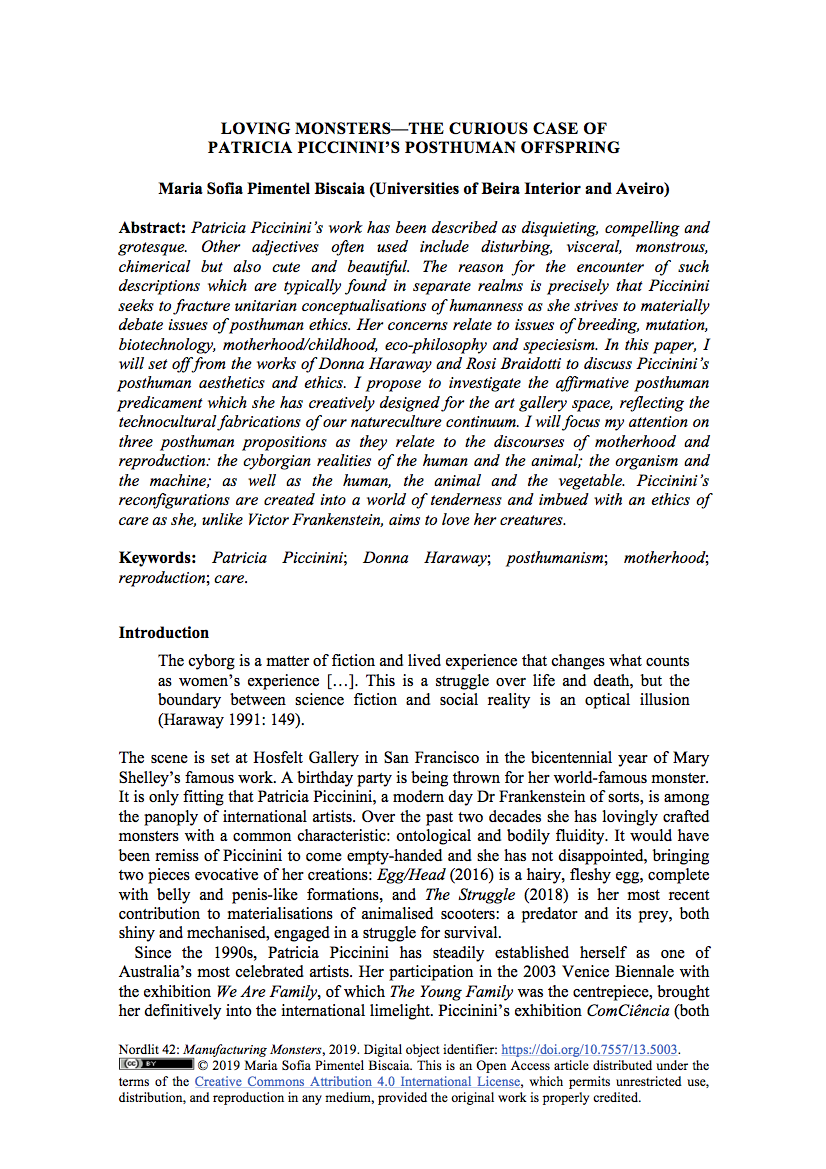Loving Monsters
The Curious Case of Patricia Piccinini’s Posthuman Offspring
DOI:
https://doi.org/10.7557/13.5003Keywords:
Patricia Piccinini, Donna Haraway, posthumanism, motherhood, reproduction, careAbstract
Patricia Piccinini’s work has been described as disquieting, compelling and grotesque. Other adjectives often used include disturbing, visceral, monstrous, chimerical but also cute and beautiful. The reason for the encounter of such descriptions which are typically found in separate realms is precisely that Piccinini seeks to fracture unitarian conceptualisations of humanness as she strives to materially debate issues of posthuman ethics. Her concerns relate to issues of breeding, mutation, biotechnology, motherhood/childhood, eco-philosophy and speciesism. In this paper, I will set off from the works of Donna Haraway and Rosi Braidotti to discuss Piccinini’s posthuman aesthetics and ethics. I propose to investigate the affirmative posthuman predicament which she has creatively designed for the art gallery space, reflecting the technocultural fabrications of our natureculture continuum. I will focus my attention on three posthuman propositions as they relate to the discourses of motherhood and reproduction: the cyborgian realities of the human and the animal; the organism and the machine; as well as the human, the animal and the vegetable. Piccinini’s reconfigurations are created into a world of tenderness and imbued with an ethics of care as she, unlike Victor Frankenstein, aims to love her creatures.
References
Braidotti, Rosi. 2002. Metamorphoses: Towards a Materialist Theory of Becoming. Cambridge: Polity Press.
Braidotti, Rosi. 2011 [1994]. Nomadic Subjects: Embodiment and Sexual Difference in Contemporary Feminist Theory. Second edition. New York: Columbia University Press.
Braidotti, Rosi. 2013. The Posthuman. Cambridge and Malden: Polity Press.
Braidotti, Rosi, and Maria Hlavajova (eds.). 2018. Posthuman Glossary. London: Bloomsbury Academic.
Garrard, Greg. 2012. Ecocriticism. New York: Routledge.
Goriss-Hunter, Anitra. 2004. “Slippery Mutants Perform and Wink at Maternal Insurrections: Patricia Piccinini’s Monstrous Cute”, Continuum—A Journal of Media and Cultural Studies 18:4, 541–553. Digital object identifier: https://doi.org/10.1080/1030431042000297653.
Haraway, Donna. 1991. “A Cyborg Manifesto: Science, Technology, and Socialist-Feminism in the Late Twentieth Century”, in Simians, Cyborgs and Women: The Reinvention of Nature, edited by Donna Haraway. New York: Routledge, 149–181.
Haraway, Donna. 2007a. “Speculative Fabulations for Technoculture’s Generations: Taking Care of Unexpected Country”, in (Tender) Creatures [exhibition catalogue], edited by Donna Haraway. Vitoria-Gasteiz: Artium, without page numbers. Available online: http://patriciapiccinini.net/writing/30/424/91 [December 22, 2018].
Haraway, Donna. 2007b. When Species Meet. Minneapolis: University of Minnesota Press.
Hennessey, Peter (dir.). 2014. Tender. Short film. Available online: https://vimeo.com/112867286 [December 22, 2018].
Jefferson, Dee. 2018. “Patricia Piccinini’s Hyperrealistic Sculptures Are a Call for Radical Empathy and Change”, ABC News, April 11. Available online: https://www.abc.net.au/news/2018-04-12/patricia-piccini-curious-affection-at-qagoma/9638564 [December 22, 2018].
McDonald, Helen. 2012. Patricia Piccinini: Nearly Beloved. Dawes Point: Piper Press.
Michael, Linda. 2003. “We Are Family: Patricia Piccinini at the 50th Biennale of Venice”, PatriciaPiccinini.net, without date. Available online: http://patriciapiccinini.net/writing/27/424/91 [December 22, 2018].
Monteith, Stephanie. 2018. “Curious Affection or ‘Monstrous Affliction’? Revisiting Patricia Piccinini”, Overland, June 26. Available online: https://overland.org.au/2018/06/curious-affection-or-monstrous-affliction-revisiting-patricia-piccinini/ [July 7, 2018].
Oziewicz, Marek. 2017. “Speculative Fiction”, Oxford Research Encyclopedia of Literature, March 11. Digital object identifier: https://doi.org/10.1093/acrefore/9780190201098.013.78.
Piccinini, Patricia. 2006. In Another Life. Exhibition catalogue. Wellington: City Gallery Wellington. Available online: http://patriciapiccinini.net/writing/28/424/91 [December 22, 2018].
Piccinini, Patricia, and Susan Johnson. 2014. Like Us: Patricia Piccinini. Exhibition catalogue. Newcastle: Newcastle Art Gallery.
Piccinini, Patricia, and Laura Fernandez Orgaz. 2007. “The Naturally Artificial World”, in (Tender) Creatures [exhibition catalogue], edited by Donna Haraway. Vitoria-Gasteiz: Artium, without page numbers. Available online: http://patriciapiccinini.net/writing/29/424/91 [December 22, 2018].
Queensland Art Gallery of Modern Art (director unknown). 2018a. Go Behind-the-Scenes as Patricia Piccinini Discusses Her Work. Short film. Available online: https://www.youtube.com/watch?v=0613V38a38s [December 22, 2018].
Queensland Art Gallery of Modern Art (director unknown). 2018b. Walk with Patricia Piccinini Through Her Exhibition ‘Curious Affection’. Short film. Available online: https://www.youtube.com/watch?v=m8Rqhi4vLT0 [December 22, 2018].
Roden, David. 2018. “Speculative Posthumanism”, in Posthuman Glossary, edited by Rosi Braidotti and Maria Hlavajova. London: Bloomsbury Academic, 398–401.
Temür, Başak Doğa. 2011. “Just Because Something Is Bad, Doesn’t Mean It Isn’t Good”, in Hold Me Close to Your Heart [exhibition catalogue], edited by Ilkay Baliç. Istanbul: Arter, without page numbers. Available online: http://patriciapiccinini.net/writing/37/424/91 [December 22, 2018].









